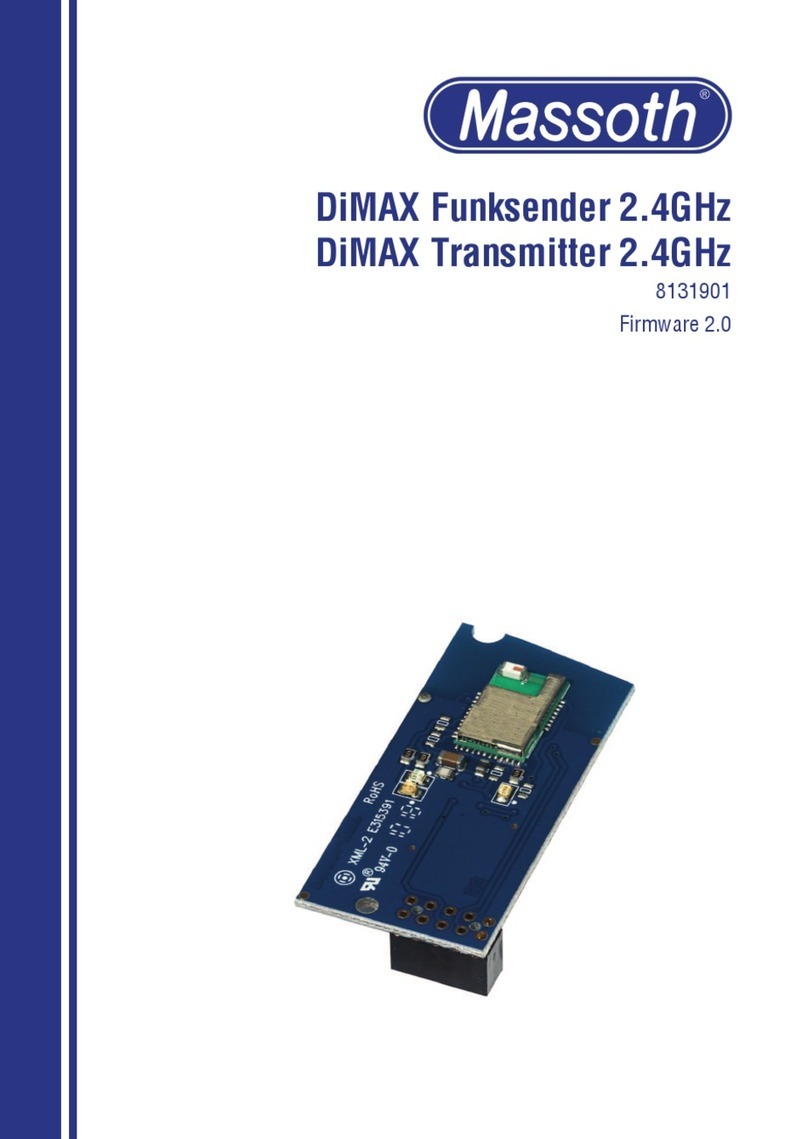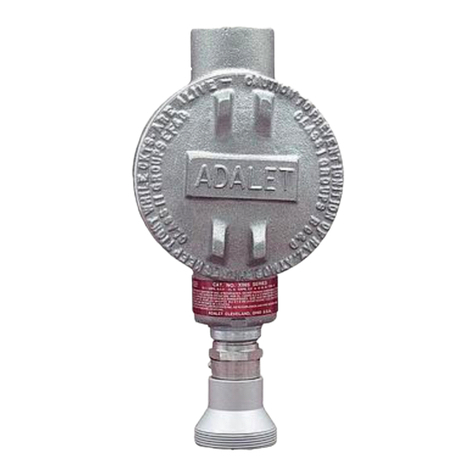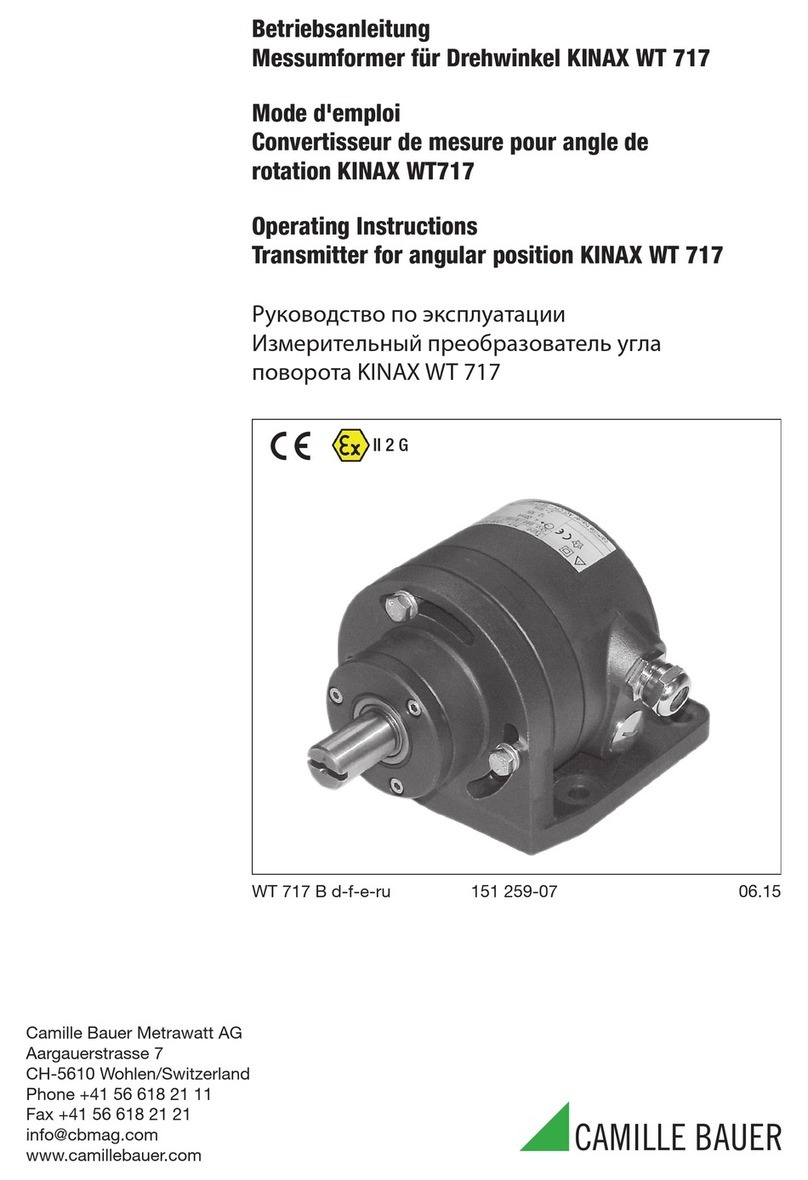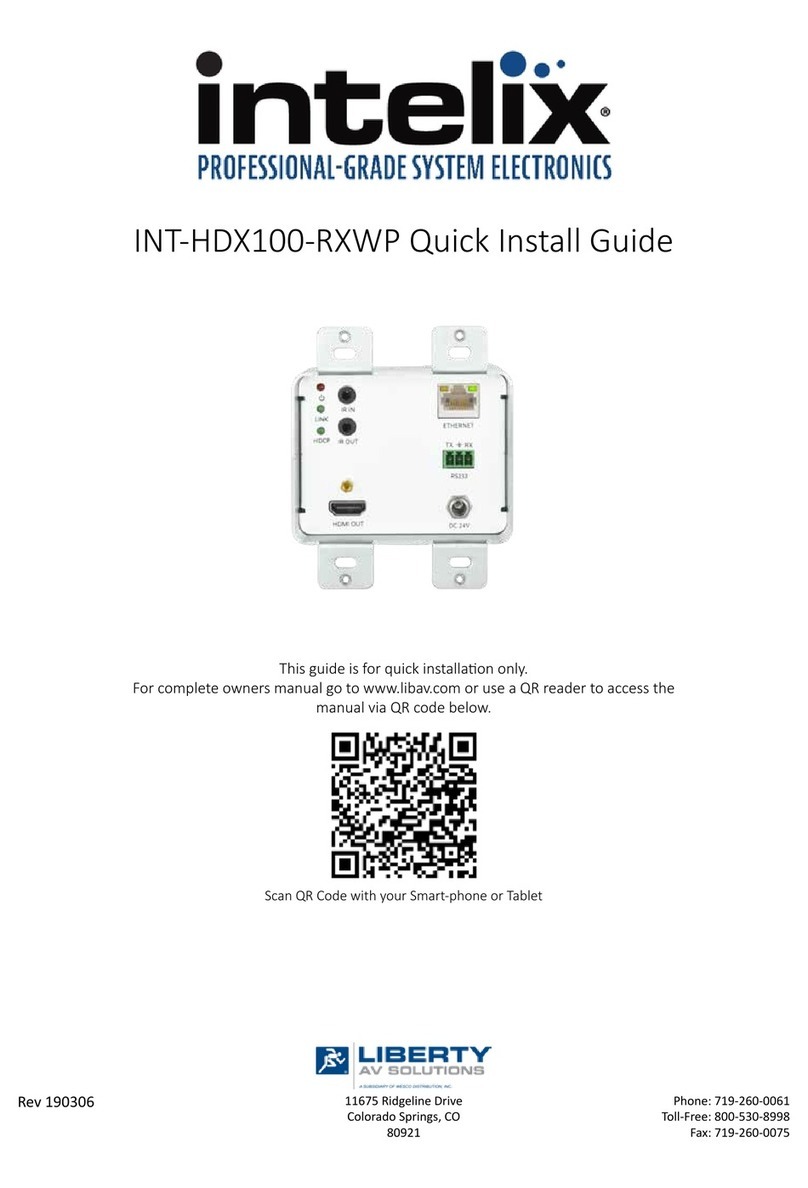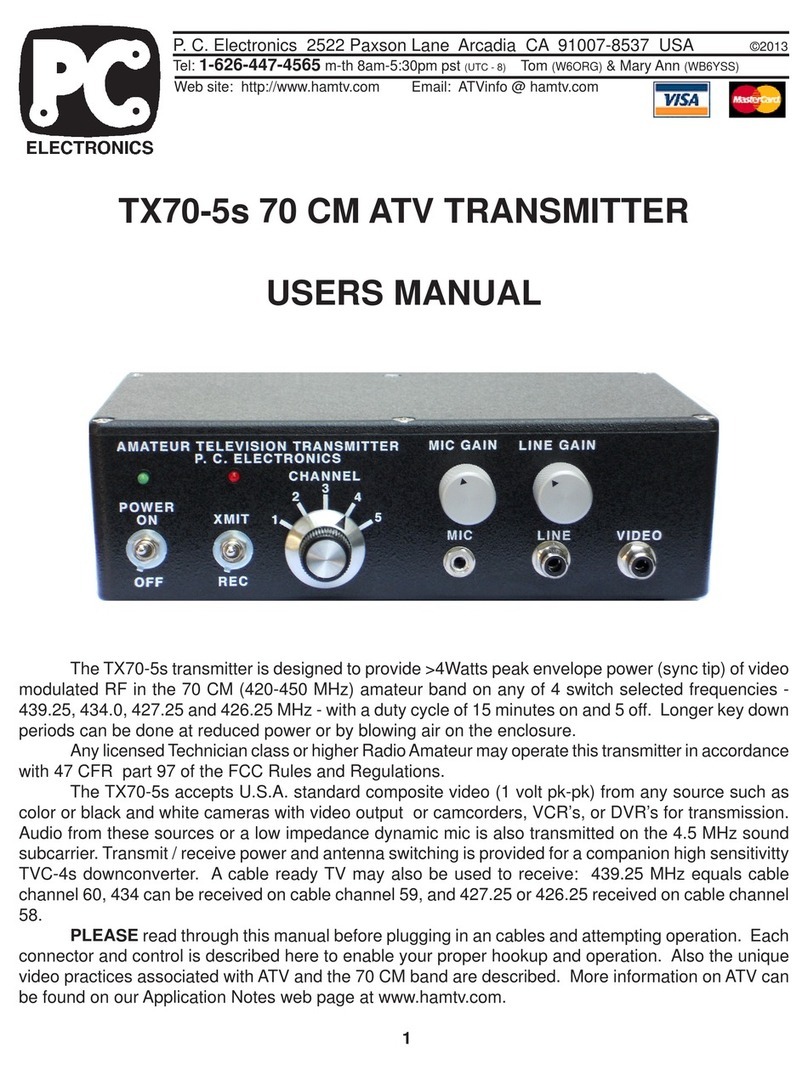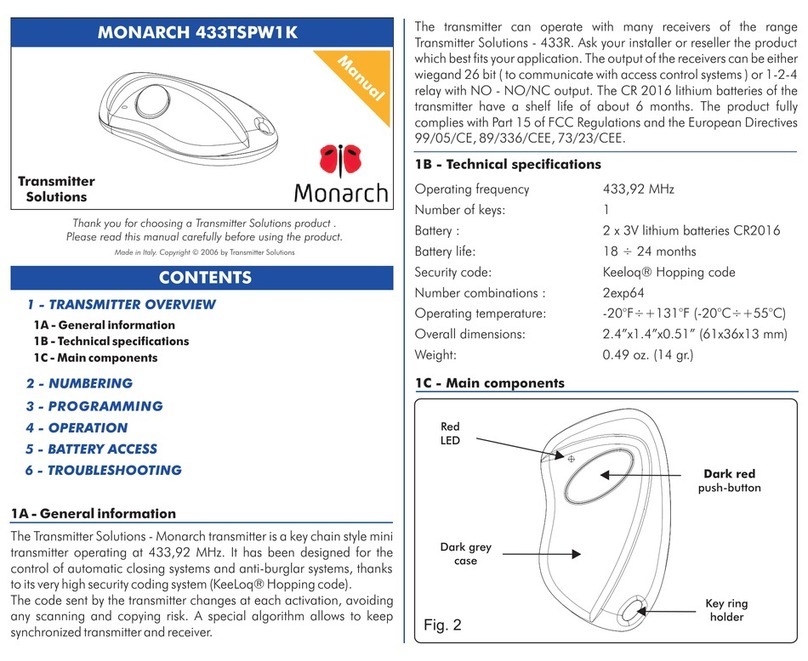ADN pesage T16F User manual

KEY TO SYMBOLS
Below are the symbols used in the manual to draw the reader's attention:
Warning! Risk of electrocution.
Warning! This operation must be performed by skilled workers.
Read the following indications carefully.
Further information.
GUARANTEE
4 months from the delivery document date. The guarantee covers only defected parts and includes the replacement parts and
labour. All shipping and packing costs are paid by the customer. It is possible to have the repair in guarantee on condition that the
returned product has not been transformed, damaged or repaired without authorization. No guarantee is applicable on returned
products without the original label and/or serial number. No guarantee against misuse.
Batteries: Adn Pesage provides 1 year guarantee from the date of delivery note, against material defects or battery manufacturing faults.
Disposal of Waste Equipme t by Users i Private Households i the Europea U io
This symbol on the product or on its packaging indicates that this product must not be disposed of with
your other household waste. It is your responsibility to dispose of your waste equipment by handing it
over to a designated collection point for the recycling of waste electrical and electronic equipment. The
separate collection and recycling of your waste equipment at the time of disposal will help preserve
natural resources and protect human health and the environment. For more information about where you
can drop off your waste equipment for recycling, please contact your local waste disposal Authority or
the equipment retailer.
ADN Pesage Transmetteur de pesage T16F : Manuel d’utilisation et d’installation

TABLE OF CONTENTS
USER WARNINGS ................................................................................................................. 1
RECOMMENDATIONS FOR CORRECT INSTALLATION OF WEIGHING INSTRUMENTS . 1
RECOMMENDATIONS FOR CORRECT INSTALLATION OF THE LOAD CELLS ............... 1
LOAD CELL INPUT TEST (QUICK ACCESS) ......................................................................... 3
LOAD CELL TESTING ............................................................................................................. 3
MAIN SPECIFICATIONS OF THE INSTRUMENT.................................................................. 4
BUFFER BATTERY .................................................................................................................. 4
TECHNICAL SPECIFICATIONS ............................................................................................ 5
ELECTRICAL CONNECTIONS .............................................................................................. 6
BASIC INFORMATION ............................................................................................................. 6
WIRING DIAGRAM................................................................................................................... 7
LED AND KEY FUNCTION .................................................................................................... 8
MENU MAP ............................................................................................................................ 9
SETPOINT ................................................................................................................................ 9
SYSTEM PARAMETERS ......................................................................................................... 9
INSTRUMENT COMMISSIONING ........................................................................................ 10
PROGRAMMING OF SYSTEM PARAMETERS .................................................................. 11
THEORETICAL CALIBRATION ............................................................................................. 11
MAXIMUM CAPACITY ................................................................................................................... 12
TARE WEIGHT ZERO SETTING .................................................................................................... 12
ZERO VALUE MANUAL ENTRY .................................................................................................... 12
REAL CALIBRATION (WITH SAMPLE WEIGHTS) ............................................................... 12
FILTER ON THE WEIGHT ...................................................................................................... 13
ANTI PEAK ..................................................................................................................................... 14
ZERO PARAMETERS ............................................................................................................ 14
RESETTABLE WEIGHT SETTING FOR SMALL WEIGHT CHANGES ......................................... 14
AUTOMATIC ZERO SETTING AT POWER-ON ............................................................................. 15
ZERO TRACKING .......................................................................................................................... 15
SETTING UNITS OF MEASURE ............................................................................................ 15
DISPLAY COEFFICIENT ................................................................................................................ 1
OUTPUTS AND INPUTS CONFIGURATION ......................................................................... 17
SEMI-AUTOMATIC TARE (NET/GROSS) .............................................................................. 18
PRESET TARE (SUBTRACTIVE TARE DEVICE) ................................................................. 19
SEMI-AUTOMATIC ZERO (WEIGHT ZERO-SETTING FOR SMALL VARIATIONS) ............ 20
PEAK ...................................................................................................................................... 20
ANALOG OUTPUT(ONLY FOR INSTRUMENTS WHERE THIS OPTION IS AVAILABLE) .. 20
SERIAL COMMUNICATION SETTING .................................................................................. 22
RS232 SERIAL COMMUNICATION ............................................................................................... 24
RS485 SERIAL COMMUNICATION ............................................................................................... 24
DIRECT CONNECTION BETWEEN RS485 AND RS232 WITHOUT CONVERTER ...................... 24
WEIGHT READING VIA SERIAL PORT ................................................................................ 25
ADN Pesage Transmetteur de pesage T16F : Manuel d’utilisation et d’installation

RS485 CONNECTION .................................................................................................................... 25
RS232 CONNECTION .................................................................................................................... 2
COMMUNICATION SETTING ......................................................................................................... 2
WEIMOD MODE ............................................................................................................................. 27
WEIRIP MODE ................................................................................................................................ 27
TEST ....................................................................................................................................... 28
DATE AND TIME SETTING .................................................................................................... 28
INFO MENU ............................................................................................................................ 28
SETPOINT PROGRAMMING ............................................................................................... 29
ALARMS .............................................................................................................................. 30
PRINTING EXAMPLES ........................................................................................................ 32
RESERVED FOR THE INSTALLER..................................................................................... 33
MENU LOCKING .................................................................................................................... 33
MENU UNLOCKING ............................................................................................................... 33
TEMPORARY MENU UNLOCKING ....................................................................................... 33
DATA DELETION AND PROGRAM SELECTION ................................................................. 33
KEYPAD OR DISPLAY LOCKING ......................................................................................... 34
DECLARATION OF CONFORMITY - EU ............................................................................. 35
ADN Pesage Transmetteur de pesage T16F : Manuel d’utilisation et d’installation

- 1 -
USER WARNINGS
RECOMMENDATIONS FOR THE PROPER USE OF WEIGHING INSTRUMENT
- Keep away from heat sources and direct sunlight
- Repair the instrument from rain (except special IP versions)
- Do not wash with water jets (except special IP versions)
- Do not dip in water
- Do not spill liquid on the instrument
- Do not use solvents to clean the instrument
- Do not install in areas subject to explosion hazard (except special Atex versions)
RECOMMENDATIONS FOR CORRECT INSTALLATION OF WEIGHING INSTRUMENTS
The termi als i dicated o the i strume t’s wiri g diagram to be co ected to earth must
have the same pote tial as the weighed structure (same earthi g pit or earthi g system). If
you are u able to e sure this co ditio , co ect with a earthi g wire the termi als of the
i strume t (i cludi g the termi al – SUPPLY) to the weighed structure.
The cell cable must be individually led to its panel input and not share a conduit with other cables;
connect it directly to the instrument terminal strip without breaking its route with support terminal
strips.
Use “RC” filters on the instrument-driven solenoid valve and remote control switch coils.
Avoid inverters in the instrument panel; if inevitable, use special filters for the inverters and separate
them with sheet metal partitions.
The panel installer must provide electric protections for the instruments (fuses, door lock switch
etc.).
It is advisable to leave the equipment always switched on to prevent the formation of condensation.
MAXIMUM CABLE LENGTHS
- RS485: 1000 metres with AWG 4, shielded and twisted cables
- RS 3 : 15 metres for baud rates up to 19 00
- Analog current output: up to 500 metres with 0.5 mm cable
- Analog voltage output: up to 300 metres with 0.5 mm cable
RECOMMENDATIONS FOR CORRECT INSTALLATION OF THE LOAD CELLS
INSTALLING LOAD CELLS: The load cells must be placed on rigid, stable in-line structures; it
is important to use the mounting modules for load cells to compensate for misalignment of the
support surfaces.
PROTECTION OF THE CELL CABLE: Use water-proof sheaths and joints in order to protect the
cables of the cells.
MECHANICAL RESTRAINTS (pipes, etc.): When pipes are present, we recommend the use of
hoses and flexible couplings with open mouthpieces with rubber protection; in case of hard pipes,
place the pipe support or anchor bracket as far as possible from the weighed structure (at a distance
at least 40 times the diameter of the pipe).
ADN Pesage Transmetteur de pesage T16F : Manuel d’utilisation et d’installation

- 2 -
CONNECTING SEVERAL CELLS IN PARALLEL: Connect several cells in parallel by using - if
necessary - a watertight junction box with terminal box. The cell connection extension cables must
be shielded, led individually into their piping or conduit and laid as far as possible from the power
cables (in case of 4-wire connections, use cables with 4x1 mm minimum cross-section).
WELDING: Avoid welding with the load cells already installed. If this cannot be avoided, place the
welder ground clamp close to the required welding point to prevent sending current through the load
cell body.
WINDY CONDITIONS - KNOCKS - VIBRATIONS: The use of weigh modules is strongly
recommended for all load cells to compensate for misalignment of the support surfaces. The system
designer must ensure that the plant is protected against lateral shifting and tipping relating to:
shocks and vibration; windy conditions; seismic conditions in the installation setting; stability of the
support structure.
EARTHING THE WEIGHED STRUCTURE: By means of a copper wire with suitable cross-section,
connect the cell upper support plate with the lower support plate, then connect all the lower plates to
a single earthing system. Electrostatic charges accumulated because of the product rubbing against
the pipes and the weighed container walls are discharged to the ground without going through or
damaging the load cells. Failure to implement a proper earthing system might not affect the
operation of the weighing system; this, however, does not rule out the possibility that the cells and
connected instrument may become damaged in the future. It is forbidden to ensure earthing system
continuity by using metal parts contained in the weighed structure.
FAILURE TO FOLLOW THE INSTALLATION RECOMMENDATIONS WILL BE CONSIDERED
A MISUSE OF THE EQUIPMENT
OK OK
NO NO
NO
OK
ADN Pesage Transmetteur de pesage T16F : Manuel d’utilisation et d’installation

- 3 -
LOAD CELL INPUT TEST (QUICK ACCESS)
From the weight display, press ▲ for 3 seconds; the response signal of the load cells is displayed,
expressed in mV with four decimals.
LOAD CELL TESTING
Load cell resista ce measureme t (use a digital multimeter):
- Disconnect the load cells from the instrument and check that there is no moisture in the cell
junction box caused by condensation or water infiltration. If so, drain the system or replace it if
necessary.
- The value between the positive signal wire and the negative signal wire must be equal or similar
to the one indicated in the load cell data sheet (output resistance).
- The value between the positive excitation wire and the negative excitation wire must be equal or
similar to the one indicated in the load cell data sheet (input resistance).
- The insulation value between the shield and any other cell wire and between any other cell wire
and the body of the load cell must be higher than 0 Mohm.
Load cell voltage measureme t (use a digital multimeter):
- Take out the load cell to be tested from underneath the container, or alternatively, lift the
container support.
- Make sure that the excitation of two wires of the load cell connected to the instrument (or
amplifier) is 5 VDC ±3%.
- Measure the response signal between the positive and the negative signal wires by directly
connecting them to the tester, and make sure that it is comprised between 0 and 0.5 mV.
- Apply load to the cell and make sure that there is a signal increment.
IF ONE OF THE ABOVE CONDITIONS IS NOT MET, PLEASE CONTACT THE TECHNICAL
ASSISTANCE SERVICE.
ADN Pesage Transmetteur de pesage T16F : Manuel d’utilisation et d’installation

- 4 -
MAIN SPECIFICATIONS OF THE INSTRUMENT
Indicator with 6-wire load cell input in DIN box (48x96x130 mm; drilling template 45x9 mm) for panel
front mounting. Front panel protection rating IP54 (IP65 front optional). 6-digit semi−alphanumeric
display, 14 mm, 7 segments; 8 indicator LEDs. 4−key membrane keypad with buzzer. Real-time
clock/calendar with buffer battery.
Two serial ports (RS485 and RS 3 ) for connection to: PC/PLC up to 3 instruments (max 99 with
line repeaters) by ASCII Adn Pesage or ModBus R.T.U. protocol, remote display, printer.
The instrument can be connected to a CLM serie intelligent junction box or to a multi-channel weight
transmitter.
BUFFER BATTERY
The instrument is equipped with an internal battery that allows to keep active the internal clock even
in the event of power failure.
At the first start and after long periods of inactivity, leave the instrument on for at least 1
hours to fully charge the battery.
ADN Pesage Transmetteur de pesage T16F : Manuel d’utilisation et d’installation

- 5 -
TECHNICAL SPECIFICATIONS
POWER SUPPLY and CONSUMPTION (VDC) 1 / 4 VDC ±10%; 5 W
NO. OF LOAD CELLS IN PARALLEL and SUPPLY max 8 (350 ohm); 5 VDC / 1 0 mA
LINEARITY / ANALOG OUTPUT LINEARITY < 0.01% F.S.; < 0.01% F.S.
THERMAL DRIFT / ANALOG OUTPUT THERMAL DRIFT < 0.0005% F.S./°C; < 0.003% F.S./°C
A/D CONVERTER 4 bit (16000000 points)
MAX DIVISIONS
(with measurement range ±10 mV = sens. mV/V) ±999999
MEASUREMENT RANGE ±39 mV
MAX SENSITIVITY OF USABLE LOAD CELLS ±7 mV/V
MAX CONVERSIONS PER SECOND 300 conversions/second
DISPLAY RANGE ±999999
NO. OF DECIMALS / DISPLAY INCREMENTS 0÷4 / x 1 x x 5 x 10 x 0 x 50 x 100
DIGITAL FILTER / READINGS PER SECOND 0.01 ÷7 s / 5÷300 Hz
RELAY LOGIC OUTPUTS N. 5 - max 115 VAC; 150 mA
(N. 4 – analog output version)
LOGIC INPUTS N. 3 - optoisolated 5 - 4 VDC PNP
(N. – analog output version)
SERIAL PORTS RS485, RS 3
BAUD RATE 400, 4800, 9600, 19 00, 38400, 115 00
HUMIDITY (non condensing) 85%
STORAGE TEMPERATURE -30°C +80°C
WORKING TEMPERATURE - 0°C +60°C
OPTOISOLATED ANALOG OUTPUT (OPTIONAL)
16 bit - 65535 divisions
0÷ 0 mA; 4÷ 0 mA (max 300 ohm);
0÷10 V; 0÷5 V; ±10 V; ±5 V (min 10 kohm)
RELAY LOGIC OUTPUTS N. 5 - max 30 VAC, 60 VDC; 150 mA
(N. 4 – analog output version)
WORKING TEMPERATURE - 0°C +50°C
Equipme t to be powered by 12-24 VDC LPS or Class 2 power source.
ADN Pesage Transmetteur de pesage T16F : Manuel d’utilisation et d’installation

- 6 -
ELECTRICAL CONNECTIONS
TERMINALS LEGEND
1 +SUPPLY (1 / 4 VDC) 13
-SUPPLY (1 / 4 VDC)
RS 3 , RS485: SHIELD, GND
E/EC OPTION: GND
14
INPUT No. 3 (+VDC min 5 V max 4 V)
otherwise:
+ANALOG OUTPUT 0÷ 0 or 4÷ 0 mA
3 RS 3 : TXD 15
OUTPUT No. 5
otherwise:
+ANALOG OUTPUT 0÷10 V
4 RS 3 : RXD 16
E/EC OPTION
otherwise:
-ANALOG OUTPUT COMMON
5 OUTPUT No. 1 17 RS485: -
6 OUTPUT No. 18 RS485: +
7 OUTPUT No. 3 19 -LOAD CELL EXCITATION (-Exc)
LOAD CELL SHIELD
8 OUTPUT No. 4 0 +LOAD CELL EXCITATION (+Exc)
9 OUTPUT COMMON 1 +LOAD CELL REF/SENSE
10 INPUT No. 1 (+VDC min 5 V max 4 V) -LOAD CELL REF/SENSE
11 INPUT No. (+VDC min 5 V max 4 V) 3 -LOAD CELL SIGNAL (-Sig)
1 INPUT COMMON (-VDC 0 V) 4 +LOAD CELL SIGNAL (+Sig)
BASIC INFORMATION
- It is recommended that the power supply negative pole be grounded.
- It is possible to supply up to eight 350 ohm load cells or sixteen 700 ohm load cells.
- For 4-wire load cells, make a jumper between EX- and REF- and between EX+ and REF+.
- Connect terminal “– SUPPLY” to the RS485 common of the connected instruments in the event
that these receive alternating current input or that they have an optically isolated RS485.
- In case of an RS485 network with several devices it is recommended to activate the 1 0 ohm
termination resistance on the two devices located at the ends of the network, as described in the
paragraph RS485 SERIAL CONNECTION.
- Option E/EC: selects 1 groups of 5 setpoint.
ADN Pesage Transmetteur de pesage T16F : Manuel d’utilisation et d’installation

- 7 -
WIRING DIAGRAM
5 outputs: controlled by setpoint values or by remote device via protocol.
3 i puts: settable to have the following functions: NET/GROSS WEIGHT, SEMI-AUTOMATIC
ZERO, PEAK, PRINT or REMOTE CONTROL (see section OUTPUTS AND INPUTS
CONFIGURATION).
(1) If the analog output is present (ANALOG OUTPUT OPTION) the following is no longer available:
▫ IN3 input
▫ OUT5 output
▫ E/EC options
RX
19
1
13
234 5 6
16
14 15 17 18
TX
12
24
7811
109
2120 22 23
IN 1
IN 2
IN COMMON
INPUTS
supply
5÷24 V C
+ 0÷20 4÷20 mA
- COMMON
+ 0÷10 V C
(1) ANALOG OUTPUT
OPTION
16
14 15
4-WIRE load cell
CONNECTION
24
SIGNAL +
19
EXCITAT. -
EXCITAT. +
SIGNAL -
2120 2322
12
EC OPTION
3
2
1
7
68
5
4
10
11
9
8
E OPTION
1 32 4 5 6 7 14119 10 1312 1615
162
162
to instrument
OUT 1
OUT 2
OUT 3
OUT 4
OUT COMMON
Current output:
max load 300 ohm
Voltage output:
min.load 10 kohm
EXCITAT. -
LOA CELLS
SIGNAL +
EXCITAT. +
SIGNAL -
REF./SENSE -
REF./SENSE +
RS485
OUT 5
IN 3
INPUT
supply
5÷24 V C
6-WIRE load cell
CONNEC ION
to IN COMMON
to OP . E - EC
RS232
- SUPPLY
+ SUPPLY
Buttons not included in the supply
OUTPUTS
max 115 VAC
150 mA
12/24 VDC
supply

- 8 -
LED AND KEY FUNCTION
LED Mai fu ctio Seco dary fu ctio *
NET net weight (semi-automatic tare or preset tare) LED lit: input 1 closed
zero (deviation from zero not more than ±0. 5 divisions) LED lit: input closed
stability LED lit: input 3 closed
kg unit of measure: kg LED lit: output 4 closed
g unit of measure: g LED lit: output 5 closed
W1
LED lit: output 1 closed
W LED lit: output closed
W3 LED lit: output 3 closed
*) To activate the secondary LED function, during weight display press and hold down MENU and
▲ keys at the same time (press MENU immediately followed by ▲).
KEY Short press Lo g press
(3 s) I to me us
Semi-automatic zero Tare resetting Cancel or return to previous
menu
Gross Net Net Gross Select figure to be modified
or go to previous menu item.
Prints actual weight mV load cell test Modify selected figure or go
to next menu item
Setting setpoint and hysteresis Confirm or enter in
submenu
+
Setting general parameters (press
immediately followed by )
+
Setting preset tare (press
immediately followed by )
Into menus LEDs light up in sequence to indicate that it is not displaying a weight.
0
ADN Pesage Transmetteur de pesage T16F : Manuel d’utilisation et d’installation

- 9 -
MENU MAP
Into menus changes are applied right after pressing the ENTER key (no further confirmation is
required).
SETPOINT
SYSTEM PARAMETERS

- 10 -
INSTRUMENT COMMISSIONING
Upon switch-on, the display shows in sequence:
- (ONLY in case of approved program);
- instrument model (e.g.: );
- followed by the software code (e.g.: );
- program type: (base);
- followed by the software version (e.g.: );
- followed by the hardware code (e.g.:
- serial number (e.g.:
Check that the display shows the weight and that when loading the load cells there is an increase in
weight. If there is not check and verify the connections and correct positioning of the load cells.
- If the i strume t has already bee theoretical CALIBRATED (plant system identification tag
present on the instrument and on the cover: load cell’s rated data already entered):
▫ Reset to zero (see section TARE WEIGHT ZERO SETTING)
▫ Check the calibration with sample weights and correct the indicated weight if necessary (see
section REAL CALIBRATION (WITH SAMPLE WEIGHTS)).
- If the i strume t HAS NOT BEEN CALIBRATED (missing plant system identification tag)
proceed with calibration:
▫ If load cells data are unknown, follow the procedure in section REAL CALIBRATION (WITH
SAMPLE WEIGHTS)
▫ Enter the rated data of load cells following the procedure given in section THEORETICAL
CALIBRATION
▫ Reset to zero (see section TARE WEIGHT ZERO SETTING)
▫ Check the calibration with sample weights and correct the indicated weight if necessary (see
section REAL CALIBRATION (WITH SAMPLE WEIGHTS)).
- If you use the analog output, set the desired analog output type and the full scale value (see
section ANALOG OUTPUT).
- If you use serial communication, set the related parameters (see section SERIAL
COMMUNICATION SETTING).
- If setpoint are used, set the required weight values and the relevant parameters (see sections
SETPOINT PROGRAMMING and OUTPUTS AND INPUTS CONFIGURATION).
- Set instrument’s clock with current date and time (see section DATE AND TIME SETTING)
ADN Pesage Transmetteur de pesage T16F : Manuel d’utilisation et d’installation

- 11 -
PROGRAMMING OF SYSTEM PARAMETERS
From the weight display, press simultaneously keys MENU and ESC to access the parameter setting.
MENU/ENTER: to enter a menu/confirm the data entry.
▲: to modify the displayed figure or menu item.
◄: to select a new figure or modify the displayed menu item.
ESC: to cancel and return to the previous menu.
THEORETICAL CALIBRATION
This fu ctio allows the load cell rated values to be set.
To perform the theoretical calibration set the following parameters in sequence:
- (default: ): The system full scale is given by one cell capacity multiplied by the
number of cells used. Example: 4 cells of 1000 kg FULL SCALE = 1000 x 4 = 4000.
The instrument is supplied with a theoretical full scale value corresponding to 10000. To
restore factory values, set 0 as full scale.
- (default: .00000 mV/V): Se sitivity is a load cell rated parameter expressed in mV/V.
Set the average sensitivity value indicated on the load cells. It’s possible to set a value between
0.50000 and 7.00000 mV/V. Example of 4-cell system with sensitivity: .00100, .00150,
.00 00, .00 50; enter .00175, calculated as ( .00100 + .00150 + .00 00 + .00 50) / 4.
- : The divisio (resolution) is the minimum weight increment value which can be
displayed. It is automatically calculated by the system according to the performed calibration, so
that it is equal to 1/10000 of full scale. It can be changed and be variable between 0.0001 and
100 with x1 x x5 x10 increments.
- By modifying the theoretical full scale, the sensitivity or divisions, the real calibration is
cancelled and the theoretical calibration only is considered valid.
- If the theoretical full scale and the recalculated full scale in real calibration (see section
REAL CALIBRATION (WITH SAMPLE WEIGHTS)) are equal, this means that the
calibration currently in use is theoretical; if they are different, the calibration in use is the
real calibration based on sample weights.
- By modifying the theoretical full scale, the sensitivity or divisions and all the system’s
parameters containing a weight value will be set to default values (setpoint, hysteresis,
etc.).
+
ADN Pesage Transmetteur de pesage T16F : Manuel d’utilisation et d’installation

- 12 -
MAXIMUM CAPACITY
: Maximum displayable weight (from 0 to max full scale; default: 0). When the weight exceeds
this value by 9 divisions, the display shows . To disable this function, set 0.
TARE WEIGHT ZERO SETTING
This me u may also be accessed directly from the weight display, holdi g dow the
key for 3 seco ds.
Perform this procedure after havi g set the THEORETICAL CALIBRATION data.
Use this function to set to zero the weight of the empty system after commissioning and then later
on to compensate zero variations due to the presence of product residues.
Procedure:
- Confirm the message by pressing ENTER.
- The weight value to be set to zero is displayed. In this phase all of the LEDs are flashing.
- Confirming once again, the weight is set to zero (the value is stored to the permanent memory).
- Press ▲ to display the value of the total weight reset by the instrument, given by the sum of all
of the previous zero settings.
ZERO VALUE MANUAL ENTRY
WARNING: Perform this procedure only if it’s not possible to reset the weighed structure tare, for
example because it contains product that cannot be unloaded.
Set in this parameter the estimated zero value (from 0 to max 999999; default: 0).
REAL CALIBRATION (WITH SAMPLE WEIGHTS)
After havi g performed the THEORETICAL CALIBRATION a d TARE WEIGHT ZERO SETTING,
this fu ctio allows correct calibratio to be do e usi g sample weights of k ow value a d, if
ecessary, a y deviatio s of the i dicated value from the correct value to be corrected.
Load onto the weighing system a sample weight, which must be at least 50% of the maximum
quantity to be weighed.
0
+
+
+
+
ADN Pesage Transmetteur de pesage T16F : Manuel d’utilisation et d’installation

- 13 -
By confirming the message the flashing value of the weight currently on the system is
displayed. In this phase all of the LEDs are off. Adjust the value on display by using the arrow keys if
necessary. After confirming, the new set weight will appear with all the LEDs flashing. After an
additional confirmation, the message will be restored and by repeatedly pressing the key
ESC the weight will once again be displayed.
Example: for a system of maximum capacity 1000 kg and 1 kg division, two sample weights are
available, one of 500 kg and the other one of 300 kg. Load both weights onto the system and correct
the indicated weight to 800. Now remove the 300 kg weight, the system must show 500; remove the
500 kg weight too; the system must read zero. If this does not happen, it means that there is a
mechanical problem affecting the system linearity.
WARNING: ide tify a d correct a y mecha ical problems before repeati g the procedure.
- If theoretical full scale and recalculated full scale in real calibration are equal, it means
that the theoretical calibration is currently in use; otherwise, the real calibration based on
sample weights is in use.
- If the correction made changes the previous full scale for more than 0%, all the
parameters with settable weight values are reset to default values.
LINEARISATION OPTION ON MAX 5 POINTS:
It is possible to perform a li earisatio of the weight repeati g the above-described procedure
up to a maximum of five poi ts, usi g five differe t sample weights. The procedure e ds by
pressi g the ESC butto or after e teri g the fifth value; at this point it will no longer be possible
to change the calibration value, but only to perform a new real calibration. To perform a new
calibration, should return to the weight display and then re-entering into the calibration menu.
By pressing ▲ after having confirmed the sample weight that has been set, the full scale appears,
recalculated according to the value of the maximum sample weight entered and making reference to
the cell sensitivity set in the theoretical calibration
FILTER ON THE WEIGHT
Setting this parameter allows a stable weight display to be obtained.
To i crease the effect (weight more stable) i crease the value (from 0 to 9, default 4).
As seen in the diagram:
- By confirming the message, the currently programmed filter value is displayed.
- By changing and confirming the value, the weight is displayed and it will be possible to
experimentally verify its stability.
- If stability is not satisfactory, confirming brings back the message and the filter may be
modified again until an optimum result is achieved.
+
ADN Pesage Transmetteur de pesage T16F : Manuel d’utilisation et d’installation

- 14 -
The filter enables to stabilise a weight as long as its variations are smaller than the corresponding
“response time”. It is necessary to set this filter according to the type of application and to the full
scale value set.
FILTER VALUE Respo se times
[ms]
Display a d serial port refresh
freque cy
[Hz]
0 1 300
1 150 100
60 50
3 4 5 5
4 (default) 850 1 .5
5 1700 1 .5
6 500 1 .5
7 4000 10
8 6000 10
9 7000 5
ANTI PEAK
When the weight is stable, the anti-peak filter removes any sudden disturbances with a maximum duration
of 1 second. Confirm the filter on the weight with ENTER and select one of the following options:
- : anti peak filter enabled (default);
- : anti peak filter disabled.
ZERO PARAMETERS
RESETTABLE WEIGHT SETTING FOR SMALL WEIGHT CHANGES
(from 0 to max full scale; default: 300; considered decimals: 300 – 30.0 – 3.00 – 0.300): this
parameter indicates the maximum weight value resettable by external contact, keypad or serial
protocol.
+
ADN Pesage Transmetteur de pesage T16F : Manuel d’utilisation et d’installation

- 15 -
AUTOMATIC ZERO SETTING AT POWER-ON
(from 0 to max 0% of full scale; default: 0): If at switch-on the weight value is lower than
the value set in this parameter and does not exceed the value, the weight is reset. To
disable this function, set 0.
ZERO TRACKING
(from 1 to 5, default: ): When the weight value is stable and, after a second, it
deviates from zero by a figure in divisions smaller or equal to the figure in divisions set in this
parameter, the weight is set to zero. To disable this function, set .
Example: if the parameter is set to 5 and is set to , the weight will be
automatically set to zero for variations smaller than or equal to 10
SETTING UNITS OF MEASURE
These are the available units of measure:
kilograms
grams
tons
pounds*
newtons*
litres*
bars*
atmospheres*
pieces*
newton metres*
: kilogram metres*
other generic units of measure not included in the list*
If the print function is enabled, the symbol corresponding to the selected unit of measure will be
printed after the measured value.
For the units marked with * it’s possible to set also the display coefficient (parameter
, see the related section). To use is necessary to enable it, closing the
input (see section OUTPUTS AND INPUTS CONFIGURATION).
+
ADN Pesage Transmetteur de pesage T16F : Manuel d’utilisation et d’installation

- 16 -
DISPLAY COEFFICIENT
By setting the coefficient the display is changed accordingly.
If one of the inputs is set to mode (see section OUTPUTS AND INPUTS
CONFIGURATION) when the input is closed the value will be displayed modified according to the
coefficient; when the input is opened the standard weight display will be restored.
: (max settable value: 99.9999; default: 1.0000) will have different meanings according to the
value set in , i.e. the selected unit of measure. (see section SETTING UNITS OF MEASURE).
If the unit of measure chosen is:
: pounds, the value set in will be multiplied by the weight value currently displayed;
: newton, the value set in will be multiplied by the weight value currently displayed;
: litres, in set the specific weight in kg/l, assuming that the system is calibrated in kg;
: bar, the value set in will be multiplied by the weight value currently displayed;
: atmosphere, the value set in will be multiplied by the weight value currently displayed;
:pieces, in set the weight of one piece;
: newton metres, the value set in will be multiplied by the weight value currently
displayed;
: kilogram metres, the value set in will be multiplied by the weight value currently
displayed;
: generic unit of measure not included in the list, the value set in will be multiplied by
the weight value currently displayed.
WARNING: All other settings (setpoint, hysteresis, calibration ...) are expressed in weight
value. If you want to convert them to the new unit of measurement, perform one of the
following procedures for changing the system calibration.
The parameter must remain set to 1.0000.
THEORETICAL CALIBRATION’S CHANGE FOR OTHER UNITS OF MEASURE
Set in the parameter the F.SCALE value divided by the conversion coefficient from kg to
the new unit of measure.
Example: The 4 load cells of 1000 kg are placed under a scale for olive oil, which has a specific
gravity of 0.916 kg/l. Setting the F.SCALE = (4 x 1000) / 0.916 = 4367, the system works in liters of
olive oil. Also, if you set the parameter (see section SETTING UNITS OF
MEASURE), the system will display and print the symbol “l” instead of “kg”.
+
ADN Pesage Transmetteur de pesage T16F : Manuel d’utilisation et d’installation
Table of contents
Other ADN pesage Transmitter manuals
Popular Transmitter manuals by other brands
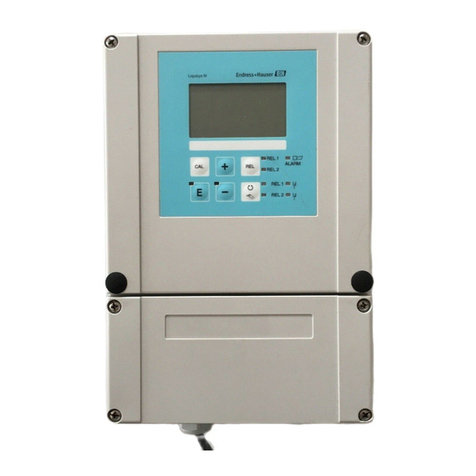
Endress+Hauser
Endress+Hauser Liquisys M CUM223 operating instructions
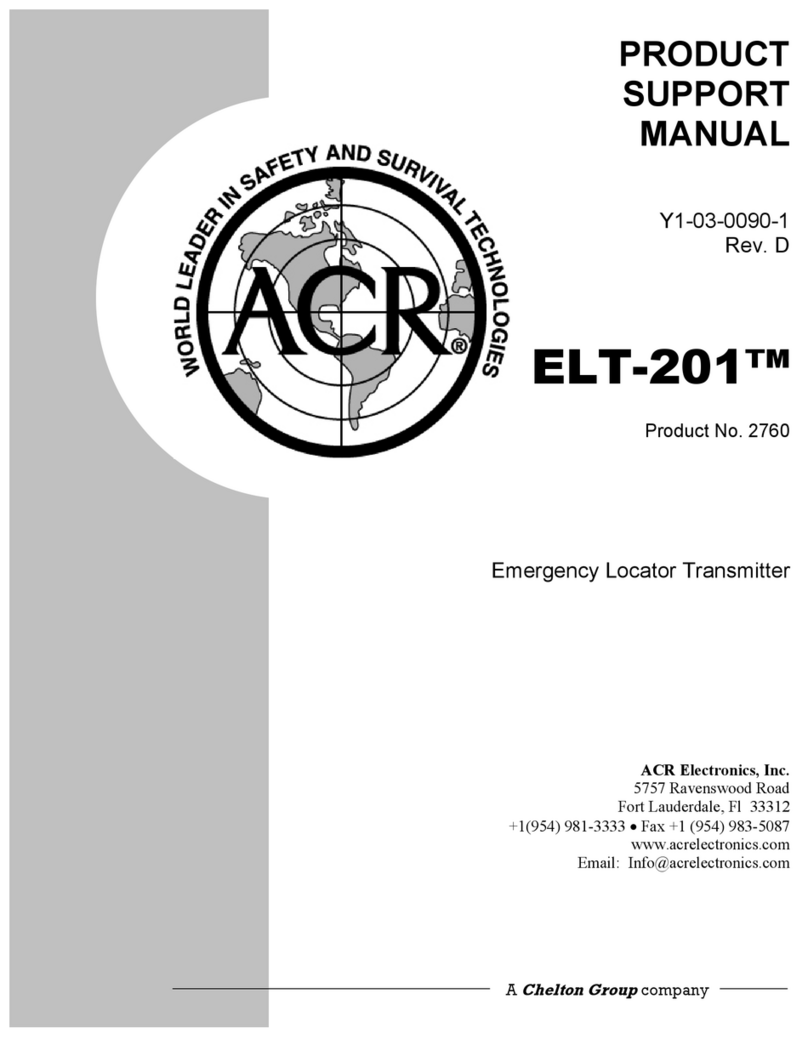
ACR Electronics
ACR Electronics ELT-201 EMERGENCY LOCATOR TRANSMITTER Product support manual
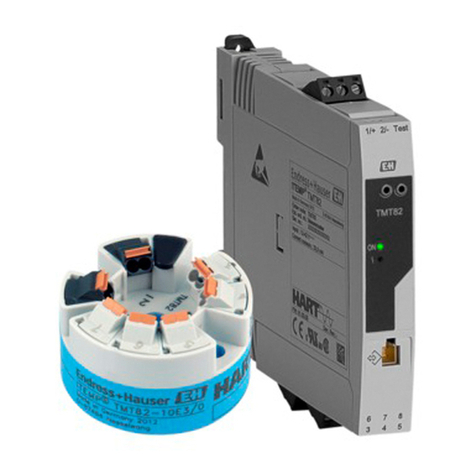
Endress+Hauser
Endress+Hauser iTEMP Safety instructions
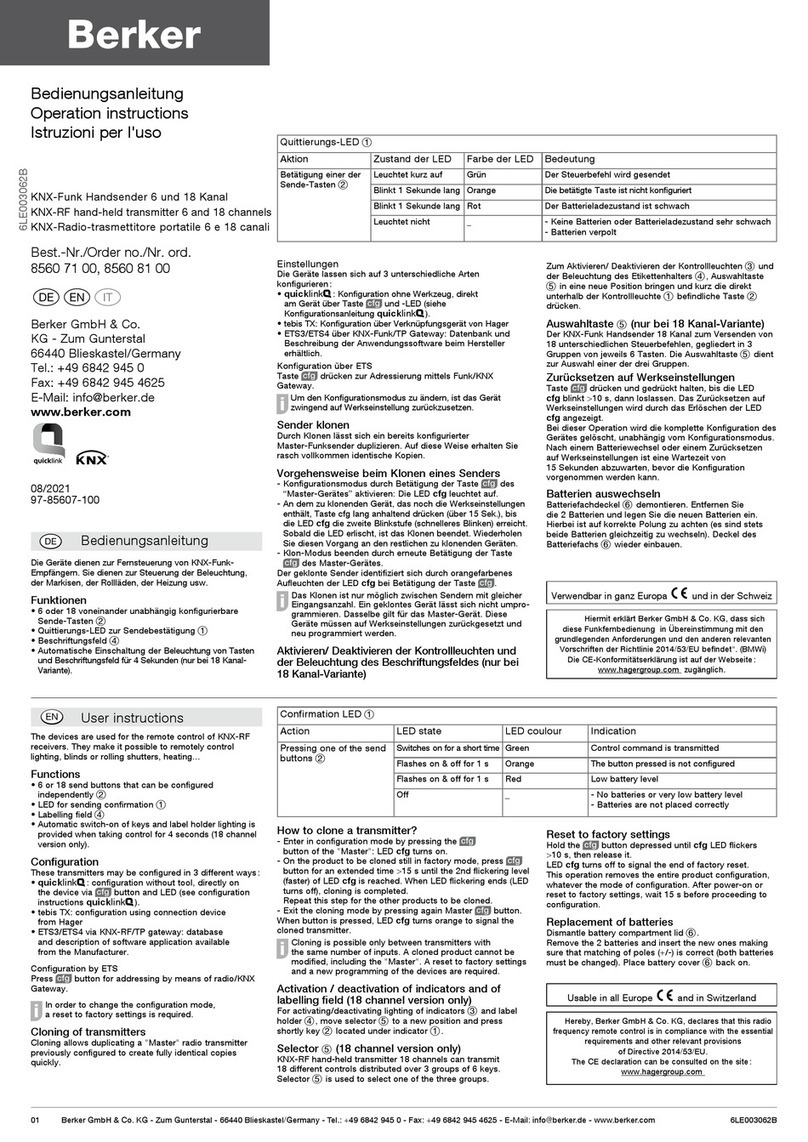
Berker
Berker 8560 71 00 Operation instructions
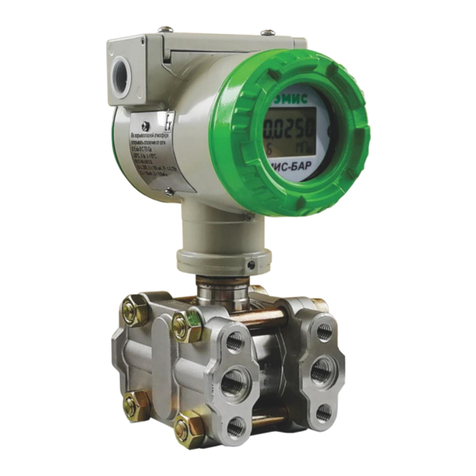
EMIS
EMIS EMIS-BAR 103 Operation manual

ARG
ARG ARG-OM-027 Manual and user guide




